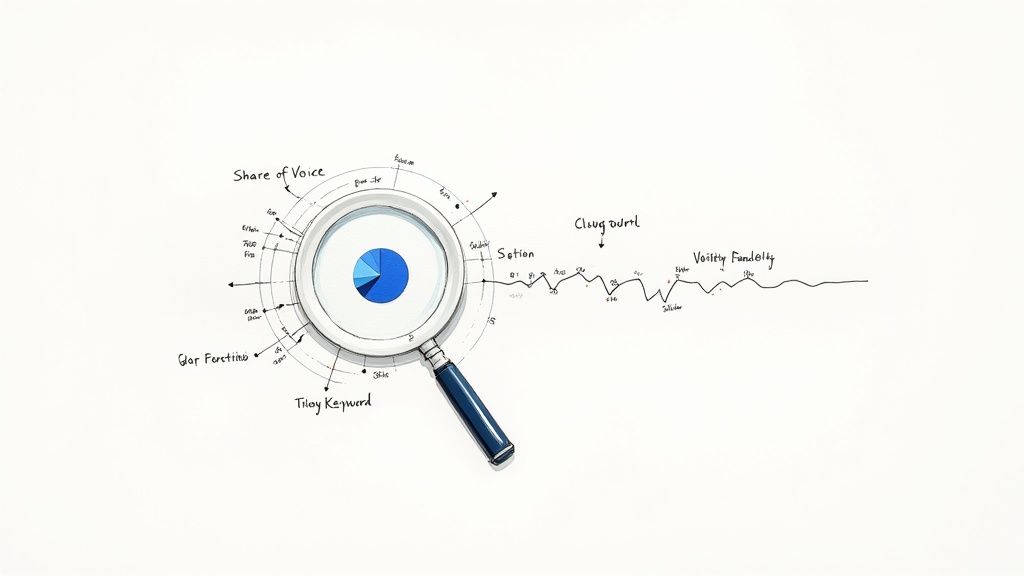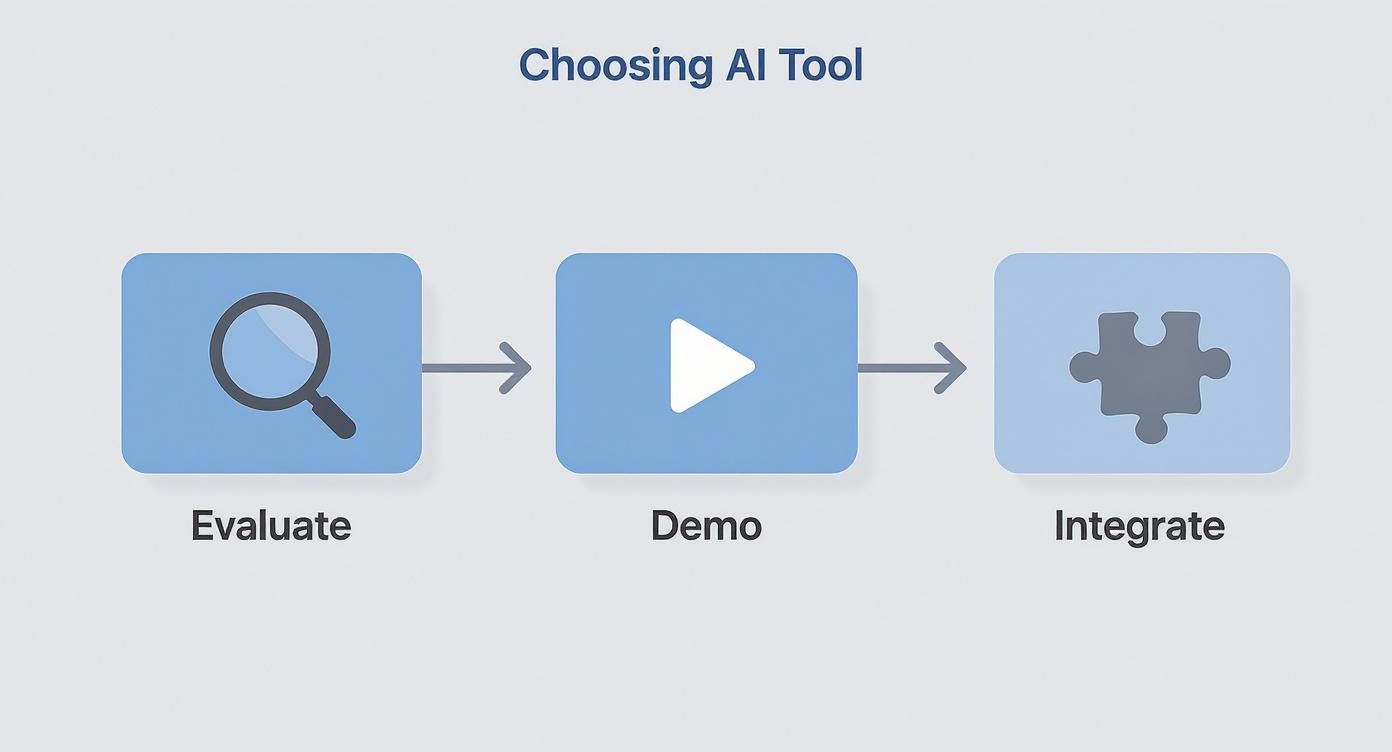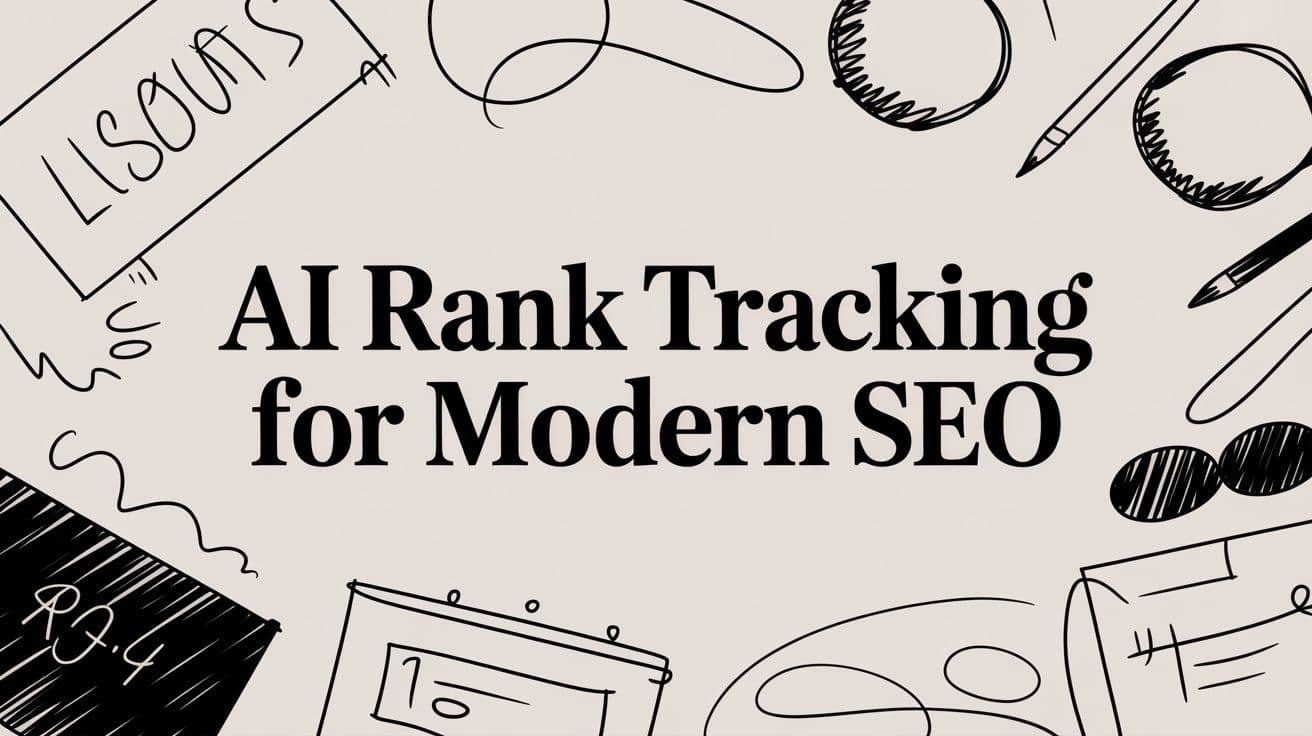Your old rank tracker is lying to you. It shows you a list of keyword positions, a neat report card of where you stood yesterday. But in the age of AI-powered search, that's like navigating a city with last year's map.
Real AI rank tracking isn't about historical data; it's a predictive engine for your search visibility. It analyzes competitor moves, SERP feature shifts, and emerging trends to tell you where the puck is going, not just where it's been. It’s the shift from reactive reporting to proactive strategy.
From Static Ranks to a Live SERP Forecast

Traditional rank tracking was a simple, reactive process. You dropped from position #3 to #8, and you only found out after the traffic was already gone.
AI rank tracking flips the entire model.
The mindset shifts from "What was my rank?" to "Where will my rank likely be next month, and what should I do about it now?"
This isn't just a minor upgrade. It’s a necessary evolution. Search engines have been using intelligent systems for decades. As early as 1992, Westlaw Is Natural (WIN) used probabilistic ranking to achieve a 30-40% improvement in retrieval accuracy for legal research. If you want to go deeper, explore the full history of AI's role in search to see its deep roots.
The Core Difference Explained
The fundamental change is moving from manual spot-checking to automated, predictive analysis. AI models can process a volume of information that no human or simple script ever could.
Let's look at how the old way stacks up against this smarter approach.
Traditional vs. AI Rank Tracking
The table below breaks down why old methods are becoming a liability.
| Feature | Traditional Rank Tracking | AI Rank Tracking |
|---|---|---|
| Data Focus | Historical keyword positions | Predictive trends and future visibility |
| Analysis Scope | Limited to a predefined keyword list | The entire SERP, including competitor moves |
| Approach | Reactive (tells you what happened) | Proactive (forecasts what might happen) |
| SERP Intelligence | Basic rank data, missing context | Detects subtle changes like new SERP features |
| Actionability | You see a drop and have to guess why | Provides insights like "a competitor is building a new topic cluster" |
| Timeframe | A rearview mirror—shows you the past | A GPS with live traffic—shows the road ahead |
AI-powered tools provide a much richer, more strategic layer of intelligence. They don't just report numbers; they surface the why behind the data.
This means you get alerted to things like:
- Competitor Movements: An AI can monitor when a competitor launches a new content cluster or gains a surge of backlinks, flagging a potential threat before it fully materializes.
- SERP Feature Changes: It detects when new "People Also Ask" boxes or video carousels appear and push organic results further down the page.
- Subtle Algorithm Updates: AI is excellent at identifying patterns that suggest a minor algorithm tweak, often before it's announced, giving you a head start to adapt.
A traditional rank tracker is a rearview mirror.
An AI rank tracker is a GPS with live traffic updates, showing you the road ahead and suggesting better routes.
This approach doesn’t replace SEO professionals. It equips them with a more powerful toolkit. It automates tedious data collection so strategists can focus on making smarter, forward-thinking decisions to secure top rankings before competitors know what’s happening.
Metrics AI Uncovers That Old Tools Miss
Your standard rank tracker tells you that you're in position #5. That’s a data point, not an answer.
The real question is why you're #5 and what it will take to hit #1. This is where AI rank tracking reveals a multi-dimensional view of your search performance, digging up metrics old tools can't process.
It turns a spreadsheet of raw data into a strategic roadmap.
True Share of Voice Across the Entire SERP
For years, "Share of Voice" meant your percentage of organic rankings for a keyword list. But today's search results are a chaotic mix of video carousels, "People Also Ask" boxes, and AI-generated overviews.
Your true visibility isn't just about the blue links anymore.
AI rank tracking calculates your holistic Share of Voice. It scans every feature on the SERP—from images to shopping results—and measures your brand's presence across all of them. This gives you a real, unfiltered look at how much attention you command.
You might celebrate a #4 organic spot while a competitor completely dominates the video results, owning a much bigger chunk of the user's screen.

This screenshot is a perfect example. Traditional organic links are now just one piece of the puzzle, making a simple rank number a dangerously incomplete metric.
Automated Keyword Clustering and Volatility Analysis
AI systems don't just see a list of keywords; they understand the relationships between them. This reveals powerful new metrics:
- Automated Keyword Clustering: AI groups related keywords into semantic clusters on the fly. This is huge for spotting gaps in topical authority. For instance, you might rank well for "project management software" but have zero visibility for a cluster of terms around "agile project tools." That's a glaring content opportunity.
- SERP Volatility Analysis: This is your early warning system. By monitoring daily fluctuations across thousands of SERPs, AI tools can pinpoint algorithm shifts in real-time. A sudden spike in volatility for your main keywords means it’s time to dig in, days before your competitors notice.
Mini Case Study #1: A B2B SaaS company used automated clustering to realize they were missing a key "integration-focused" topic cluster. They created three new landing pages to cover these keywords and captured a 20% increase in qualified demo requests within a single quarter.
Predictive Rank Forecasting
This might be the most important metric: Predictive Rank Forecasting. By analyzing your historical performance, competitor actions, and SERP volatility, AI models can forecast the likely future position of your keywords.
This isn't a crystal ball. It’s about using probabilities to make smarter bets with your budget.
If an AI model forecasts that a high-value keyword has a 70% chance of reaching the top 3 with focused effort, you know exactly where to point your resources. You gain a much clearer understanding of how to improve your AI search visibility by chasing opportunities with the highest probable return.
How to Track Your Performance in SGE and AI Overviews

The rise of Google's AI Overviews and Search Generative Experience (SGE) completely changes what "visibility" means. Chasing a static blue link is no longer the only prize.
This new reality shatters traditional rank tracking. The answers AI systems generate are fluid and personalized, often summarizing information so well that users never need to click. Your old tools can't measure your influence inside an AI-generated answer.
This is where advanced ai rank tracking comes in. It doesn't obsess over your position in a list of ten links. Instead, it measures your presence within the AI-generated answers themselves.
Measure Citations and Brand Mentions, Not Just Ranks
The critical shift is from tracking rankings to tracking citations. When an AI like Google's generates an answer, it often weaves together information from multiple sources. Getting your content cited in these AI snapshots is the new page one.
AI-native tracking tools monitor these new metrics:
- Citation Frequency: How often is your domain cited as a source when AI answers questions about your industry?
- Brand Mentions: Is your brand name-dropped directly in the AI's response, even without a link?
- Contextual Share of Voice: For a query like “best accounting software,” what percentage of the AI's answer is shaped by your content versus your competitors'?
This is a move from measuring position to measuring influence. It answers the question: "Is our expertise shaping the AI's understanding of our market?"
Keeping an eye on this is non-negotiable. A study from Authoritas (2023) found that 52% of sources cited in Google’s AI Overviews already rank on the first page. This shows a clear connection between traditional SEO authority and AI visibility. To win, you must understand how to rank in Google SGE by becoming the most citable source.
Mini Case Study #2: Finding the SGE Visibility Gap
A B2B SaaS company sold project management software. A traditional rank tracker showed them at #3 for "agile project management tools." They thought they were winning.
But an ai rank tracking platform told a different story. For that same query in SGE, the AI-generated answer cited two competitors and didn't mention them once. The AI snapshot was pulling feature comparisons and pricing data from other sites that laid it all out more clearly.
Armed with that insight, the company overhauled its product pages, adding structured data and crisp comparison tables. Within a month, their brand started appearing as a key source in the SGE results. They weren't just climbing a rank; they were becoming part of the answer.
How to Choose the Right AI Rank Tracking Tool
Not all AI rank tracking tools are the same. The market is flooded with platforms making big promises, but the real value is in the data quality. Choosing the right one isn’t about finding the tool with the most features; it’s about finding the one with the right features.
It all starts with asking better questions.
Look Beyond the Marketing Claims
Before booking a demo, you need a way to evaluate these tools. The goal is to figure out if you're getting genuine intelligence or just more noise. The data has to be accurate, specific, and integrate with your existing tools.
Here’s a checklist of critical questions to bring to any sales call:
- Data Accuracy & Refresh Rate: How often is the data updated? SERPs change hourly, so a 24-hour refresh cycle is already out of date.
- Granularity of Reporting: Can I break down data by location (city or ZIP code), device, and search engine?
- Competitor Analysis Depth: Does the tool just list competitor ranks, or can it analyze their SERP feature ownership and content strategies?
- Integration Capabilities: How well does it connect with Google Analytics and Search Console? You must link ranking data directly to traffic and conversions.
We saw a small agency cut its client reporting time by 60% just by switching to a true AI platform. The tool didn't just track ranks; it uncovered new keyword clusters that led to a 25% traffic increase for a key client in three months. That's the difference between data reporting and data intelligence.
Essential Features for Modern SEO
Once you've covered the basics, look for features built specifically for AI-driven search. You need a tool that understands the new rules of visibility. When looking at potential ai rank tracking solutions, it's smart to check out a variety of products, like those you might find in microestimates' range of tools.
Here are the non-negotiables:
- SGE and LLM Visibility Tracking: Can the platform measure your brand’s presence inside AI-generated answers? It needs to track citations and mentions, not just blue links.
- SERP Feature Analysis: The tool should show your "Share of Voice" across all parts of the SERP, like video carousels, "People Also Ask" boxes, and image packs.
- Predictive Forecasting: One of the biggest advantages of AI is forecasting ranking potential. Ask how the model works and what data it uses to make these predictions.
The best tool gives you the clearest, most actionable path to improving your performance. It should connect your SEO efforts directly to business goals. Finding that software starts with understanding the most accurate AI visibility metrics that matter today.
How to Put AI Rank Tracking Insights Into Action
So, you’ve got a powerful ai rank tracking tool. It’s spitting out predictive forecasts, SERP volatility warnings, and competitor insights. That's great, but without a clear process, that data is just noise.
This isn’t about adding more tasks to your schedule. It’s about creating a simple, repeatable system where AI insights flow directly into your content briefs, technical fixes, and link-building priorities.
When you get this right, you create a powerful feedback loop—a cycle of continuous, data-driven improvement.
Build Your Action-Oriented SEO Cadence
The key is to establish a rhythm. Some insights demand immediate action, while others shape long-term strategy. A solid cadence ensures nothing important slips through the cracks.
Here’s a simple framework:
- Daily Check (5-10 Minutes): Rapid threat detection. Scan for major anomalies, sudden drops, or weird spikes.
- Weekly Review (30-60 Minutes): This is where tactics are born. Dive into performance trends for your most important keyword clusters. This session fuels your content planning for the week ahead.
- Monthly Review (1-2 Hours): Time to zoom out. Use predictive forecasts to adjust your long-term strategy, set new goals, and decide where to allocate resources next quarter.
Choosing the right tool is the first step, but integrating it into a workflow like this is what drives results.

Case in Point: An Agency's Weekly Review
A small agency with a dozen e-commerce clients implemented a strict weekly review. Every Monday morning, they analyzed keyword cluster performance in their AI rank tracker.
One week, the data flagged a sudden 30% visibility drop for their client’s "organic skincare" cluster. But the AI tool didn't just show the drop; it flagged why. A competitor had just published three new blog posts targeting long-tail variations of that topic.
The insight wasn't "ranks dropped." It was "ranks dropped because a competitor just executed a specific content play."
Instead of guessing, the agency immediately drafted two counter-content briefs. Because they caught it early, they regained the lost visibility within two weeks. That's the power of a process.
Your Monthly Strategic Check-In
Your monthly meeting is where you look at the whole forest. This is where predictive forecasts from your ai rank tracking tool become invaluable.
You’re looking for signals. Which keyword clusters have the highest forecasted growth potential? Where is the market heading? This data can be used to improve all kinds of SEO efforts, including specialized Creator SEO strategies.
If your tool predicts a rising trend around "AI-powered sales tools," that's hard data you can use to justify allocating more budget to build out that content pillar.
This transforms SEO from a reactive checklist into a proactive growth engine. You stop making decisions based on gut feelings and start making smarter bets based on what the data says is coming next.
AI Rank Tracking Workflow Template
This schedule helps turn AI data into concrete SEO actions.
| Frequency | Key Metric to Review | Actionable Output |
|---|---|---|
| Daily | Anomaly Detection & Volatility Alerts | Escalate major drops to the technical team or pause paid campaigns pointing to affected pages. |
| Weekly | Keyword Cluster Performance | Identify underperforming content for refresh/update briefs; spot competitor content wins to analyze. |
| Monthly | Predictive Forecasts & Trend Analysis | Adjust quarterly content strategy; allocate budget to high-potential topic areas; set new KPIs. |
Use this template as a starting point and customize it to fit your team. The goal is consistency.
Common Questions About AI Rank Tracking
Jumping into new tech brings up good questions. It's normal to wonder about the cost, accuracy, or what it means for your job. Here are straight answers to common hesitations.
Is AI Rank Tracking More Expensive?
Some advanced platforms have a higher sticker price than old-school rank trackers. But the real story is the ROI. Think about the hidden costs of not using AI.
Traditional tools leave you with hours of manual work trying to connect dots that AI links in seconds. AI tools give you that time back, freeing your team to focus on high-level strategy. They also spot revenue opportunities and flag potential rank drops before they become expensive problems.
When you weigh the predictive insights and the hours saved, most find that AI tools more than pay for themselves.
How Accurate Are AI Predictive Forecasts?
The accuracy of any prediction comes down to the quality of the AI model and the amount of data it has to learn from.
The best tools are transparent about this. But let's be clear: no forecast is 100% perfect. These predictions reveal trends and probabilities, not unbreakable certainties.
Think of it like a weather forecast for the SERPs. It’s a powerful guide that helps you plan your strategy, showing which keyword clusters are worth prioritizing based on their likely future value.
Can AI Rank Tracking Replace an SEO Professional?
No. This is the biggest myth out there.
An ai rank tracking platform is a tool that makes a great SEO professional even better. The AI is fantastic at surfacing data and insights, but it still takes a sharp strategist to interpret that information in the context of a business and make smart, creative calls.
It handles the tedious parts of data collection. This lets smart people do what they do best: build winning strategies, dream up amazing content, and outthink the competition.
Your Next Step
Stop relying on a rearview mirror. The only way to win in modern SEO is to see the road ahead. AI rank tracking provides the map.
- Audit Your Current Tool: Does it measure citations in AI Overviews? Does it provide predictive forecasts? If not, it's holding you back.
- Schedule Two Demos: Find two platforms that meet the criteria in this guide and see them in action. Ask them the hard questions.
- Integrate and Act: Choose a tool and immediately build a daily, weekly, and monthly cadence around its insights.
Ready to see how your brand shows up in AI-generated answers? AI SEO Tracker gives you the tools to monitor your visibility in ChatGPT, Gemini, and more. Stop guessing and start measuring what matters. Discover your AI rankings today.

